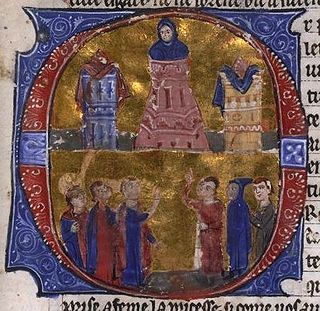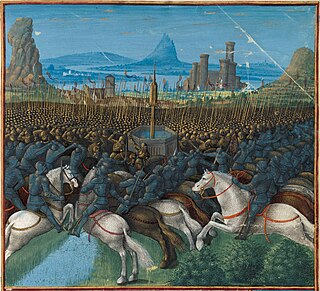
Salah al-Din Yusuf ibn Ayyub, commonly known as Saladin, was the founder of the Ayyubid dynasty. Hailing from a Kurdish family, he was the first sultan of both Egypt and Syria. An important figure of the Third Crusade, he spearheaded the Muslim military effort against the Crusader states in the Levant. At the height of his power, the Ayyubid realm spanned Egypt, Syria, Upper Mesopotamia, the Hejaz, Yemen, and Nubia.

Raynald of Châtillon, also known as Reynald or Reginald, was a knight of French origin who became Prince of Antioch from 1153 to 1160 or 1161 and Lord of Oultrejordain from 1175 until his death. The second son of a French noble family, he joined the Second Crusade in 1147, and settled in the Kingdom of Jerusalem as a mercenary. Six years later, he married Constance, Princess of Antioch, in spite of her subjects' opposition.

The Battle of Hattin took place on 4 July 1187, between the Crusader states of the Levant and the forces of the Ayyubid sultan Saladin. It is also known as the Battle of the Horns of Hattin, due to the shape of the nearby extinct volcano of that name.

The Ayyubid dynasty, also known as the Ayyubid Sultanate, was the founding dynasty of the medieval Sultanate of Egypt established by Saladin in 1171, following his abolition of the Fatimid Caliphate of Egypt. A Sunni Muslim of Kurdish origin, Saladin had originally served Nur ad-Din of Syria, leading Nur ad-Din's army in battle against the Crusaders in Fatimid Egypt, where he was made Vizier. Following Nur ad-Din's death, Saladin was proclaimed as the first Sultan of Egypt by the Abbasid Caliphate, and rapidly expanded the new sultanate beyond the frontiers of Egypt to encompass most of the Levant, in addition to Hijaz, Yemen, northern Nubia, Tarabulus, Cyrenaica, southern Anatolia, and northern Iraq, the homeland of his Kurdish family. By virtue of his sultanate including Hijaz, the location of the Islamic holy cities of Mecca and Medina, he was the first ruler to be hailed as the Custodian of the Two Holy Mosques, a title that would be held by all subsequent Sultans of Egypt until the Ottoman conquest of 1517. Saladin's military campaigns in the first decade of his rule, aimed at uniting the various Arab and Muslim states in the region against the Crusaders, set the general borders and sphere of influence of the Sultanate of Egypt for the almost three and a half centuries of its existence. Most of the Crusader states, including the Kingdom of Jerusalem, fell to Saladin after his victory at the Battle of Hattin in 1187. However, the Crusaders reconquered the coast of Palestine in the 1190s.

The Zengiddynasty was a Sunni Muslim dynasty of Turkoman origin, which ruled parts of the Levant and Upper Mesopotamia on behalf of the Seljuk Empire and eventually seized control of Egypt in 1169. In 1174 the Zengid state extended from Tripoli to Hamadan and from Yemen to Sivas. The dynasty was founded by Imad ad-Din Zengi.

Bohemond III of Antioch, also known as Bohemond the Child or the Stammerer, was Prince of Antioch from 1163 to 1201. He was the elder son of Constance of Antioch and her first husband, Raymond of Poitiers. Bohemond ascended to the throne after the Antiochene noblemen dethroned his mother with the assistance of the lord of Armenian Cilicia, Thoros II. He fell into captivity in the Battle of Harim in 1164, but the victorious Nur ad-Din, atabeg of Aleppo released him to avoid coming into conflict with the Byzantine Empire. Bohemond went to Constantinople to pay homage to Manuel I Komnenos, who persuaded him to install a Greek Orthodox patriarch in Antioch. The Latin patriarch of Antioch, Aimery of Limoges, placed Antioch under interdict. Bohemond restored Aimery only after the Greek patriarch died during an earthquake in 1170.

Al-Kamil was a Kurdish Muslim ruler and the fourth Ayyubid sultan of Egypt. During his tenure as sultan, the Ayyubids defeated the Fifth Crusade. He was known to the Frankish crusaders as Meledin, a name by which he is still referred to in some older western sources. As a result of the Sixth Crusade, he ceded West Jerusalem to the Christians and is known to have met with Saint Francis.

The Battle of Cresson was a small battle between Frankish and Ayyubid forces on 1 May 1187 at the "Spring of the Cresson." While the exact location of the spring is unknown, it is located in the environs of Nazareth. The conflict was a prelude to decisive defeat of the Kingdom of Jerusalem at the Battle of Hattin two months later.

The siege of Jerusalem lasted from 20 September to 2 October 1187, when Balian of Ibelin surrendered the city to Saladin. Earlier that summer, Saladin had defeated the kingdom's army and conquered several cities. Balian was charged with organizing a defense. The city was full of refugees but had few soldiers. Despite this fact the defenders managed to repulse several attempts by Saladin's army to take the city by storm. Balian bargained with Saladin to buy safe passage for many, and the city was peacefully surrendered with limited bloodshed. Though Jerusalem fell, it was not the end of the Kingdom of Jerusalem, as the capital shifted first to Tyre and later to Acre after the Third Crusade. Latin Christians responded in 1189 by launching the Third Crusade led by Richard the Lionheart, Philip Augustus, and Frederick Barbarossa separately. In Jerusalem, Saladin restored Muslim holy sites and generally showed tolerance towards Christians; he allowed Orthodox and Eastern Christian pilgrims to visit the holy sites freely—though Frankish pilgrims were required to pay a fee for entry. The control of Christian affairs in the city was handed over to the Ecumenical Patriarch of Constantinople.

Sahyun Castle, also known as the Castle of Saladin, is a medieval castle in northwestern Syria. It is located 7 km east of Al-Haffah town and 30 km east of the city of Latakia, in high mountainous terrain on a ridge between two deep ravines and surrounded by forest, the site has been fortified since at least the mid 10th century. In 975 the Byzantine Emperor John I Tzimiskes captured the site and it remained under Byzantine control until around 1108. Early in the 12th century the Franks assumed control of the site and it was part of the newly formed Crusader state of the Principality of Antioch. The Crusaders undertook an extensive building programme, giving the castle much of its current appearance. In 1188 it fell to the forces of Saladin after a three-day siege. The castle was again besieged in 1287, this time both defender and belligerent were Mamluks. In 2006, the castles of Qal'at Salah El-Din and Krak des Chevaliers were recognised as a World Heritage Site by UNESCO. The site is owned by the Syrian government.

The Citadel of Damascus is a large medieval fortified palace and citadel in Damascus, Syria. It is part of the Ancient City of Damascus, which was listed as a UNESCO World Heritage Site in 1979.
Darkush is a town in northern Syria, administratively part of the Idlib Governorate, located northwest of Idlib along the Syrian–Turkish borders on the Orontes River. Nearby localities include al-Janudiyah, Zarzur and al-Najiyah to the southwest, Jisr al-Shughur to the south and Millis and Maarrat Misrin to the east. According to the Syria Central Bureau of Statistics, Darkush had a population of 5,295 in the 2004 census. The town is also the administrative center of the Darkush nahiyah which consists of 19 villages with a combined population of 23,022. Its inhabitants are predominantly Sunni Muslims.

Muhammad ibn Hamed Isfahani , more popularly known as Imad ad-din al-Isfahani, was a historian, scholar, and rhetorician of Persian origin. He left a valuable anthology of Arabic poetry to accompany his many historical works and worked as a man of letters during the Zengid and Ayyubid period.
Kafartab was a town and fortress in northwestern Syria that existed during the medieval period between the fortress cities of Maarat al-Numan in the north and Shaizar to the south. It was situated along the southeastern slopes of Jabal al-Zawiya. According to French geographer Robert Boulanger, writing in the early 1940s, Kafartab was "an abandoned ancient site" located 2.5 mi (4.0 km) northwest of Khan Shaykhun.
The Banu Munqidh, also referred to as the Munqidhites, were an Arab family that ruled an emirate in the Orontes Valley in northern Syria from the mid-11th century until the family's demise in an earthquake in 1157. The emirate was initially based in Kafartab before the Banu Munqidh took over the fortress of Shayzar in 1081 and made it their headquarters for the remainder of their rule. The capture of Shayzar was the culmination of a long, drawn-out process beginning with the Banu Munqidh's nominal assignment to the land by the Mirdasid emir of Aleppo in 1025, and accelerating with the weakened grip of Byzantine rule in northern Syria in the 1070s.
The siege of Edessa in October–November 1146 marked the permanent end of the rule of the Frankish Counts of Edessa in the city on the eve of the Second Crusade. It was the second siege the city had suffered in as many years, the first siege of Edessa having ended in December 1144. In 1146, Joscelyn II of Edessa and Baldwin of Marash recaptured the city by stealth but could not take or even properly besiege the citadel. After a brief counter-siege, Zangid governor Nūr al-Dīn took the city. The population was massacred and the walls razed. This victory was pivotal in the rise of Nūr al-Dīn and the decline of the Christian city of Edessa.
The siege of Safed was part of Saladin's invasion of the Kingdom of Jerusalem.
The Siege of Loadicea took place in July 1188 between the Ayyubid Sultanate led by Saladin and the Principality of Antioch, who held modern-day Latakia. After a few days of siege, the city was captured.
The Siege of Sahyun Castle took place in July 1188 between the Ayyubid Sultanate led by Saladin and the Knights Hospitaller, who held Sahyun Castle. After a few days of siege, the city was captured.
The Siege of Ash-Shughur took place in August 1188 between the Ayyubid Sultanate led by Saladin and the Principality of Antioch, who held modern-day Jisr ash-Shughur. Saladin captured the two fort lying there.











